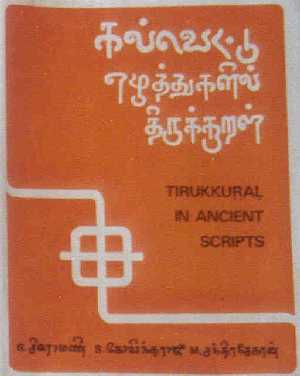

Home | Biodata | Biography | Photo Gallery | Publications | Tributes
Epigraphy

 |

Home | Biodata | Biography | Photo Gallery | Publications | Tributes Epigraphy |
 |
How old are the earliest Tamil inscriptions? Where are they found? What was the Script used for writing early Tamil? These are some of the interesting questions one would like to ask.
It is now fairly well established that the earliest Tamil inscriptions belong to the pre-Christian era, possibly going back to the second or the third centuries B.C. Early Tamil inscriptions are found from Kanchipuram in the north to Tirunelveli in the south and going as far west as Aracchalur near Erode. Inscriptions are found on rock-shelters used by Jain ascetics, on pot sherds and on some coins.
The letters used for writing early Tamil, closely resemble the Brahmi script of Asoka who ruled over the greater part of India during the third century B.C. It is from Asoka Brahmi that all the various scripts of India evolved.
Scholars have observed two notational systems of Brahmi for writing Tamil. The first system is older than the second and the latter is very close to the Asokan Brahmi system. In the first system the short medial, a, is marked by a short horizontal stroke. In the second system the same mark indicates a long medial a. For example, scholars once used to read a certain word as maakaana following the second system. It did not make much sense. When the first system was used to read the inscription, the meaning became clear. The same word was read as makan, a common Tamil word for son.
These two systems of Brahmi are different from the Tamil Pulli system described in Tholkappiam. So far the earliest records of the Pulli or the dot, are found on a coin of a Satavahana king and on a coin of one Sendan and these coins belong to the second century A.D. In the numerous inscriptions found on rock-shelters on hillocks near Madurai, scholars have failed to observe the Pulli in any of the inscriptions.
The occurrence of the Pulli is closely linked with the date of Tholkappiam believed to be the oldest Tamil work. The late occurrence of the Pulli in Tamil inscriptions will indicate a later date for Tholkappiam.
An enthusiastic group of students of Mathematics from American College, Madurai have taken to the study of ancient Tamil inscriptions in and around Madurai. At the top of Anaimalai near Madurai, they read a known Tamil Brahmi inscription, now made accessible by steps thoughtfully provided by the Department of Archaeology. The inscription is about 2000 years old and refers to a donation of rock shelter or bed to a resident of the hill.
One of the students observed a circular dot about one cm in diameter next to the letter
T in the
word ARATTA KAAYIPAN. The dot is found in the middle of the line and not above the line. This is the earliest record of the occurrence of the
Pulli in a Tamil Brahmi inscription. This shows that the Pulli system existed from very early times. Hence
Tholkappiam can be dated to a period earlier than what has been hitherto accepted by epigraphists.